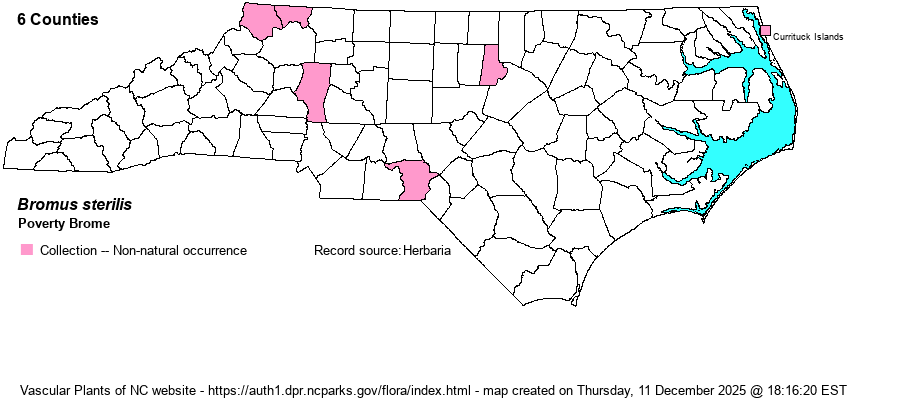| Author | L. | |
| Distribution | Scattered records from the northern Mountains, Piedmont, and Sandhills; disjunct to the Outer Banks of Currituck County. The Sandhills specimen (at DUKE) needs an ID check.
Native to Europe; in N.A. scattered from MA to B.C., south to LA, TX, and CA. | |
| Abundance | Apparently rare. Could easily be overlooked as it closely resembles B. tectorum. | |
| Habitat | Dry sandy roadsides, clearings, disturbed ground. | |
| Phenology | Flowering and fruiting May-June. | |
| Identification | Poverty Brome is closely similar to B. tectorum and both have drooping spikelets when mature. However, Poverty Brome has longer awns and glumes -- see Weakley (2018) for measurements. | |
| Taxonomic Comments | Bromus is an important genus of grasses for their value as forage (many species) or for the harm they cause to the guts of grazing animals (a few species). In most of our species, inflorescences arch over and cause the spikelets to droop; thus the plants are often graceful looking. Bromus, Festuca, and Poa all can look quite similar to beginners (and even veterans!), because they all have multi-flowered spikelets. Generally speaking, Bromus taxa have much the largest spikelets, and most Poa taxa have a tuft of wispy hairs at the base of each floret (lacking in the other genera). Bromus and Festuca taxa have obvious awns on the florets that are absent in Poa taxa. With field experience and careful use of keys, one can eventually handle these genera. | |
| Other Common Name(s) | | |
| State Rank | SE | |
| Global Rank | GNR | |
| State Status | | |
| US Status | | |
| USACE-agcp | | |
| USACE-emp | | |

